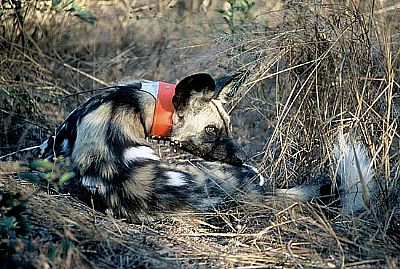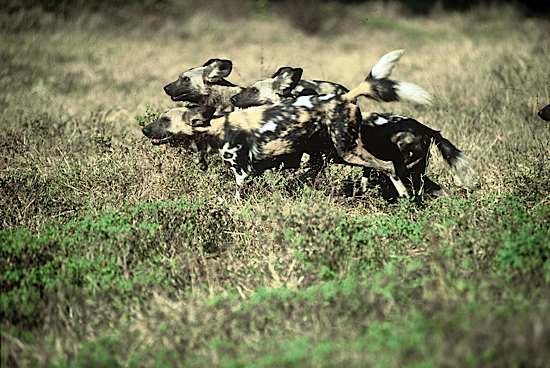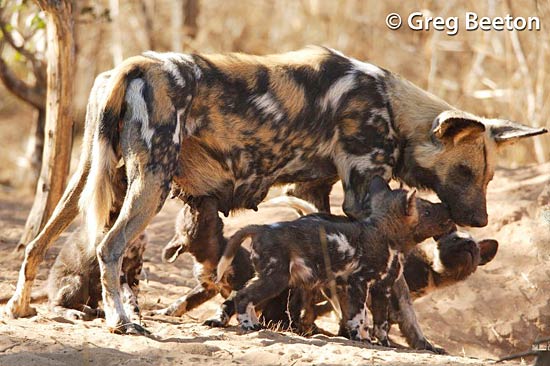PDC - A Model for Conservation
PDC's focal research activities are to monitor distribution, densities and demography in order to understand direct and indirect threats to packs in the greater Hwange ecosystem and the Zambezi Valley.
 Results continue to highlight that the painted dog population in Hwange National Park (HNP) is in a precarious state with only 32 individuals known from a 5065 km2 sample area of the park and only four dogs in the Gwayi that in recent history had a population of at least three packs numbering a total of 36 dogs. On a positive note, a December 2011 estimate showed a marginal improvement from 70-80 dogs to 90 dogs (including pups), but still far from a potential capacity for the range of 350 dogs. Mean adult and yearling pack size for the park is currently 4.4 which though marginally up from 2010, falls well short of a minimum pack size of six, which is considered essential for both denning-helper needs and the necessity to meet energetic requirements for reproduction. This shortfall in helpers and inability to bank energy is reflected in total reproductive failure in 80% of the packs where data were obtainable.
Results continue to highlight that the painted dog population in Hwange National Park (HNP) is in a precarious state with only 32 individuals known from a 5065 km2 sample area of the park and only four dogs in the Gwayi that in recent history had a population of at least three packs numbering a total of 36 dogs. On a positive note, a December 2011 estimate showed a marginal improvement from 70-80 dogs to 90 dogs (including pups), but still far from a potential capacity for the range of 350 dogs. Mean adult and yearling pack size for the park is currently 4.4 which though marginally up from 2010, falls well short of a minimum pack size of six, which is considered essential for both denning-helper needs and the necessity to meet energetic requirements for reproduction. This shortfall in helpers and inability to bank energy is reflected in total reproductive failure in 80% of the packs where data were obtainable.
Failure of the Hwange packs is considered to be directly related to a reduced prey base and the opening up of the habitat, which both affect hunting success. For many years, waterholes have been maintained in HNP via the provision of diesel pumps. It's complicated and controversial. Initial research results show that the effect of a pumped water hole on the vegetation, which can be simply described as overgrazing, conservatively extends to 17 kilometres from its centre. There is therefore only a very small part of HNP that is not affected by the pumping of water. Tragically, due to conditions inside HNP being unfavourable for painted dogs, when territories are vacant (caused by road traffic accidents and snaring) resident HNP packs leave the park and so create a destructive sink effect.

Research in the Zambezi valley, which commenced in Mana Pools NP in 2010, has highlighted a more optimistic picture. The first pack collared now numbers 28 individuals, an increase of five from November 2010 and is a wonderful sight to behold. Preliminary sightings data indicate that there could be another four or five packs and a total estimated number of 70 dogs in close relative proximity, indicating the possibility of a valuably large population that requires more detailed data to confirm. There are, however, indications from similarity in coat patterns as well as flopped ears that there could be an inbreeding depression, and consequently a detailed DNA study needs to be carried out.

The translocation of the Ukusutha pack to the Victoria Falls Private Game Reserve was a highlight of 2011 and quite possibly one of the most significant conservation exercises for painted dogs that PDC has undertaken. Creating a new pack at the project's Rehabilitation Centre and then releasing them back into the wild where they learned to hunt and live wild was a great success until the alpha male was killed by lions and his pack disintegrated. The three females were subsequently recaught and have just been relocated to Gonarezhou National Park, in the Lowveldt region of Zimbabwe. The reason for moving them so far (over 1000km from Victoria Falls) is that research data shows that Gonarezhou National Park, and the Lowveldt region as a whole, has the lowest genetic diversity of any painted dog population in Africa. The new bloodline provided by these three females should be invaluable.



